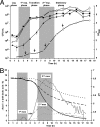Mixed-culture transcriptome analysis reveals the molecular basis of mixed-culture growth in Streptococcus thermophilus and Lactobacillus bulgaricus
- PMID: 20889781
- PMCID: PMC2988612
- DOI: 10.1128/AEM.01122-10
Mixed-culture transcriptome analysis reveals the molecular basis of mixed-culture growth in Streptococcus thermophilus and Lactobacillus bulgaricus
Abstract
Many food fermentations are performed using mixed cultures of lactic acid bacteria. Interactions between strains are of key importance for the performance of these fermentations. Yogurt fermentation by Streptococcus thermophilus and Lactobacillus bulgaricus (basonym, Lactobacillus delbrueckii subsp. bulgaricus) is one of the best-described mixed-culture fermentations. These species are believed to stimulate each other's growth by the exchange of metabolites such as folic acid and carbon dioxide. Recently, postgenomic studies revealed that an upregulation of biosynthesis pathways for nucleotides and sulfur-containing amino acids is part of the global physiological response to mixed-culture growth in S. thermophilus, but an in-depth molecular analysis of mixed-culture growth of both strains remains to be established. We report here the application of mixed-culture transcriptome profiling and a systematic analysis of the effect of interaction-related compounds on growth, which allowed us to unravel the molecular responses associated with batch mixed-culture growth in milk of S. thermophilus CNRZ1066 and L. bulgaricus ATCC BAA-365. The results indicate that interactions between these bacteria are primarily related to purine, amino acid, and long-chain fatty acid metabolism. The results support a model in which formic acid, folic acid, and fatty acids are provided by S. thermophilus. Proteolysis by L. bulgaricus supplies both strains with amino acids but is insufficient to meet the biosynthetic demands for sulfur and branched-chain amino acids, as becomes clear from the upregulation of genes associated with these amino acids in mixed culture. Moreover, genes involved in iron uptake in S. thermophilus are affected by mixed-culture growth, and genes coding for exopolysaccharide production were upregulated in both organisms in mixed culture compared to monocultures. The confirmation of previously identified responses in S. thermophilus using a different strain combination demonstrates their generic value. In addition, the postgenomic analysis of the responses of L. bulgaricus to mixed-culture growth allows a deeper understanding of the ecology and interactions of this important industrial food fermentation process.
Figures

Similar articles
-
Genome-Scale Metabolic Modeling Combined with Transcriptome Profiling Provides Mechanistic Understanding of Streptococcus thermophilus CH8 Metabolism.Appl Environ Microbiol. 2022 Aug 23;88(16):e0078022. doi: 10.1128/aem.00780-22. Epub 2022 Aug 4. Appl Environ Microbiol. 2022. PMID: 35924931 Free PMC article.
-
Characterization of Streptococcus thermophilus two-component systems: In silico analysis, functional analysis and expression of response regulator genes in pure or mixed culture with its yogurt partner, Lactobacillus delbrueckii subsp. bulgaricus.Int J Food Microbiol. 2011 Dec 2;151(2):171-81. doi: 10.1016/j.ijfoodmicro.2011.08.019. Epub 2011 Sep 8. Int J Food Microbiol. 2011. PMID: 21978656
-
Effect of lactose hydrolysis on the milk-fermenting properties of Lactobacillus delbrueckii ssp. bulgaricus 2038 and Streptococcus thermophilus 1131.J Dairy Sci. 2021 Feb;104(2):1454-1464. doi: 10.3168/jds.2020-19244. Epub 2020 Dec 11. J Dairy Sci. 2021. PMID: 33309355
-
Selective and differential enumerations of Lactobacillus delbrueckii subsp. bulgaricus, Streptococcus thermophilus, Lactobacillus acidophilus, Lactobacillus casei and Bifidobacterium spp. in yoghurt--a review.Int J Food Microbiol. 2011 Oct 3;149(3):194-208. doi: 10.1016/j.ijfoodmicro.2011.07.008. Epub 2011 Jul 21. Int J Food Microbiol. 2011. PMID: 21807435 Review.
-
Harnessing the metabolic potential of Streptococcus thermophilus for new biotechnological applications.Curr Opin Biotechnol. 2020 Feb;61:142-152. doi: 10.1016/j.copbio.2019.12.019. Epub 2020 Jan 13. Curr Opin Biotechnol. 2020. PMID: 31945498 Review.
Cited by
-
A model of proteolysis and amino acid biosynthesis for Lactobacillus delbrueckii subsp. bulgaricus in whey.Curr Microbiol. 2012 Dec;65(6):742-51. doi: 10.1007/s00284-012-0214-4. Epub 2012 Sep 18. Curr Microbiol. 2012. PMID: 22986815
-
Metabolic Pathway Profiling in Intracellular and Extracellular Environments of Streptococcus thermophilus During pH-Controlled Batch Fermentations.Front Microbiol. 2020 Jan 21;10:3144. doi: 10.3389/fmicb.2019.03144. eCollection 2019. Front Microbiol. 2020. PMID: 32038577 Free PMC article.
-
Food Spoilage-Associated Leuconostoc, Lactococcus, and Lactobacillus Species Display Different Survival Strategies in Response to Competition.Appl Environ Microbiol. 2018 Jun 18;84(13):e00554-18. doi: 10.1128/AEM.00554-18. Print 2018 Jul 1. Appl Environ Microbiol. 2018. PMID: 29678911 Free PMC article.
-
Comparative transcriptomic analysis of Lactiplantibacillus plantarum RS66CD biofilm in high-salt conditions and planktonic cells.PeerJ. 2020 Aug 3;8:e9639. doi: 10.7717/peerj.9639. eCollection 2020. PeerJ. 2020. PMID: 32832272 Free PMC article.
-
Genomic and phenotypic imprints of microbial domestication on cheese starter cultures.Nat Commun. 2024 Oct 5;15(1):8642. doi: 10.1038/s41467-024-52687-7. Nat Commun. 2024. PMID: 39366947 Free PMC article.
References
-
- Baldi, P., and A. D. Long. 2001. A Bayesian framework for the analysis of microarray expression data: regularized t-test and statistical inferences of gene changes. Bioinformatics 17:509-519. - PubMed
-
- Bolotin, A., B. Quinquis, P. Renault, A. Sorokin, S. D. Ehrlich, S. Kulakauskas, A. Lapidus, E. Goltsman, M. Mazur, G. D. Pusch, M. Fonstein, R. Overbeek, N. Kyprides, B. Purnelle, D. Prozzi, K. Ngui, D. Masuy, F. Hancy, S. Burteau, M. Boutry, J. Delcour, A. Goffeau, and P. Hols. 2004. Complete sequence and comparative genome analysis of the dairy bacterium Streptococcus thermophilus. Nat. Biotechnol. 22:1554-1558. - PMC - PubMed
-
- Bringel, F., and J. C. Hubert. 2003. Extent of genetic lesions of the arginine and pyrimidine biosynthetic pathways in Lactobacillus plantarum, L. paraplantarum, L. pentosus, and L. casei: prevalence of CO2-dependent auxotrophs and characterization of deficient arg genes in L. plantarum. Appl. Environ. Microbiol. 69:2674-2683. - PMC - PubMed
-
- Broadbent, J. R., D. J. McMahon, D. L. Welker, C. J. Oberg, and S. Moineau. 2003. Biochemistry, genetics, and applications of exopolysaccharide production in Streptococcus thermophilus: a review. J. Dairy Sci. 86:407-423. - PubMed
-
- Brouwer, R. W., S. A. F. T. van Hijum, and O. P. Kuipers. 2009. MINOMICS: visualizing prokaryote transcriptomics and proteomics data in a genomic context. Bioinformatics 25:139-140. - PubMed
MeSH terms
Substances
Associated data
- Actions
LinkOut - more resources
Full Text Sources
Other Literature Sources
Molecular Biology Databases

